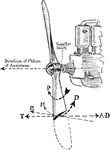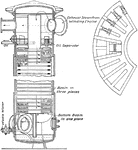
Interior View of Rateau Accumulator
"The accumulator may consist of a large tank in which are numerous plates over which water can flow,…
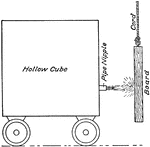
Apparatus for Measuring Jet Stream of Steam
"Suppose a hollow cube to be filled with some fluid (water or steam) at a given pressure, and to have…

Back Axle of Leyland Six Ton Petrol Wagon
A back axle of a Leyland petrol wagon illustrating direct drive. The middle casing houses the reducing…

Side View of Barford and Perkins Water Ballast Rollers
A side view of Barford and Perkins water—ballast rollers. The vehicle operated using an internal…

Yorkshire Steam Wagon Transverse Boiler
A Yorkshire steam wagon transverse boiler. Water is continuously enters the large cylindrical container.…
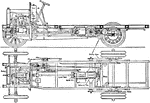
Internal and Chassis View of Albion Car
A side internal and chassis view of Albion car. The car has 16 horsepower and weighs 2 tons. The shaft,…

Steam Engine Valve Centered with Piston
"It is usual to put the engine on center before setting the valve. First put the engine in a position…

Chassis of Barford and Perkins Water Ballast Rollers
An internal combustible Barford and Perkins water ballast rollers chassis. The fuel tank is located…
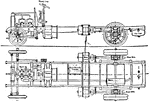
Hallford Stevens Petrol Electric Vehicle Chassis with Two Back Motors
A Hallford—Stevens petrol—electric vehicle. The vehicle is considered to be an early hybrid…

Top View of Six Cylinder 1910 Rolls Royce Chassis with Engine and Axle
An illustration of the Rolls Royce chassis with engine and axle viewed form the top. A chassis is the…

Six Ton Wagon Chassis
"One of the chief advantages of the side—chain drive lies in the fact that there is, with it,…

Colonel Crompton's Superheated Steam Tractor
A superheated steam tractor built by Colonel Crompton. The boiler, located in the front, heats the water,…

Eccentric Motion of the Steam Engine Crank in Full Gear
"When set full gear forward, the valve admits steam to the crank end of the cylinder, and the crank…
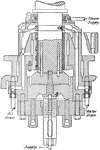
Cross Sectional View of Curtis Turbine Step Bearing
"The upper bearing with dowel—pins and key fit into corresponding dowel holes and key—way…
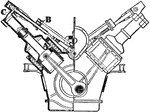
Bentley Eight Cylinder Diagonal Tandem Compound Superheated Steam Engine for Tractor
A eight cylinder Bentley superheated steam engine fitted to a tractor. The steam is used to move the…
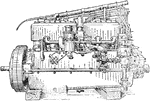
Carburetor Side View of Six Cylinder Rolls Royce Engine
A six cylinder Rolls Royce engine viewed from the carburetor side. The carburetor is used to mix air…
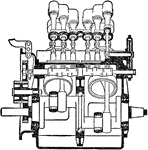
Sheppee Motor Company Compact Double Acting SUperheated Engine
"In this engine the cam—shaft by which the steam and exhaust valves are operated is situated midway…

Steam Engine with Reynolds Corliss Gear
"An eccentric on the main shaft gives an oscillating motion to a circular disc called the wrist plate,…

Turbine Engine
The inner workings of the Carmania. A description of how the ship gets power in order to move on the…
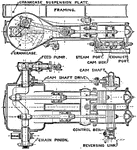
Twin Cylinder Steam Engine Fitted to Sentinel Wagons
Illustration showing a twin cylinder steam engine fitted to a sentinel wagon. The steam expands and…

Cross Sectional View of U.S.S Salem Steam Engine Showing Curtis Turbines
"The marine turbine of this type (Curtis turbine) installed in the U.S. Cruiser Salem had seven pressure…

Valve Side View of Six Cylinder Rolls Royce Engine
A valve side view of the six cylinder Rolls Royce engine, showing the location of the magneto. The magneto…

Dennis Six Cylinder Fire Engine with Centrifugal Pump
A six cylinder fire engine with Gwynne centrifugal pump by Dennis Brothers Ltd. The engine have a retractable…

Six Cylinder Halley Fire Engine with centrifugal pump
A Halley six cylinder fire engine with centrifugal pump. The fire engine pumps water from the tank in…
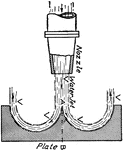
Force Measurement by Deflecting Water Jet 180 Degrees
"Now if the plate were shaped as shown, so that the direction of the jet were completely reversed turned…

Cross Sectional View of Four Stage Vertical Riedler Stumpf Turbine
A cross sectional view of a four stage vertical Riedler—Stumpf turbine. The steam enters and exit,…
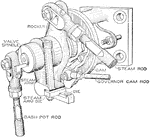
Steam Engine Brown Releasing Gear
"The governor cam rod operates a plate cam having a curved slot so shaped that it takes place of both…

Joy Steam Engine Valve Gear Rotating Wheel
A Joy valve gear for steam engine rotating the wheel in the direction of the arrow. The lever F changes…

Outline of a Steam Engine Marshall Gear Reducing Friction and Wear
An outline of the Marshall gear from a steam engine. The piston rotates the crank shaft at point H around…

Close up of Reynolds Corliss Gear from Steam Engine
"The steam arm is keyed to the valve spindle which passes loosely through a bracket on which the bell—crank…

Steam Engine with Walschaert Gear on Railroad
An illustration of the steam engine with Walschaert gear system on rail tracks. The piston moves the…
Close up View of Double Sliding Valve Gears from Steam Engine
"The main valve controls admission, release, and compression; the other (valve) regulates the cut—off…
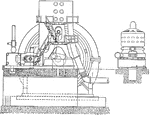
5000 kW Corliss and Curtis Steam Engine for Electric Generation
An illustration of a Corliss steam engine to generate 5000 kW of electricity. The turbines to create…

Corliss Steam Engine Generator Plan
"By placing the condensers underneath the turbine, as is frequently done at the present time, not only…

Cross Section View of Rateau Turbine Electric Generator by Western Electric Company
A cross sectional view of Rateau electric generator turbine by Western Electric Company. Steam is used…

DeLaval Steam Electric Generator
"The bearings are of the plain ring—oiling type, usually provided with water jackets. The shaft…

Westinghouse Turbo Steam Engine Generator Plan
"Turbines require very much smaller foundations than reciprocating engines reciprocating engines of…

Zoelly Condensing Turbine Electric Generator
"The Zoelly turbine has been developed rather extensively abroad, and is being manufactured largely…
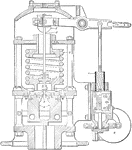
Sectional View of Governor for Varying Number of Nozzles Opened
"In the Curtis turbine, steam is admitted through a series of valves, the number of which depends upon…
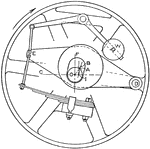
Top View of the Fly Wheel Governor Turning Clockwise
"All fly—wheel governors operate by shifting the eccentric either to change the angular advance,…

Turbine Governor for Varying Time of Admission
"An admission of steam occurs about once in every thirty revolutions at approximately full load. The…
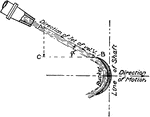
Jet Steam Stream Hitting Curved Vane
"If a jet with the velocity V strikes the bucket at an angle a, its velocity A B could be resolved into…

Steam Engine Gooch Link and Valve Gear Arrangement
"As the speed increases, and the link is 'notched up', the lead is increased as the cut—off is…

Cross Sectional View of Parsons Turbine
"Steam enters at E and gradually expands in volume until it exhausts at G. The rotor is usually built…
Steam Engine Valve with Lap Connected to Rocker
"This occurs in horizontal engines when the valve is set on top of the cylinder instead of on one side.…

Valve with Lap of Steam Engine at Extreme Left with Exhaust Ports Open
"Since the valve must move a distance equal to the outside lap before admission can take place, it is…

Steam Engine Valve with Lap Steam Where Slide Valve is Closed
"The relative positions of crank, eccentric and valve when the exhaust closes on the crank end and compression…

Steam Engine Valve with Lap Where Steam is Admitted to the Slide Valve
"While the crank is moving from the position, steam is being admitted to the head end and being exhausted…

Steam Engine Valve with Lap Steam Where Slide Valve is in Open Position
An illustration of the valve with lap at the end of the crank end steam compression. The piston will…

Steam Engine Valve with Lap Steam Where Slide Valve Moved to Open Position
"If the inside lap is increased, the valve must move farther before released occurs and the crank angle…

Steam Engine Rocker Arrangement with Valve and Reverse Rod in Eccentric Motion
"This arrangement makes it possible to place the valve and steam chest above the valve motion. A rod…

Marshall's Agricultural Hydraulic Gear Tractor
A Marshall's agricultural hydraulic gear tractor. The fuel tank is located on the bottom back of the…
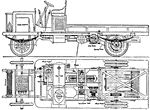
Steam Operated Tractor with Outside Spring Suspension
A tractor compound steam engine with outside suspension spring. The spring suspension helps stabilize…

Thornycroft Military Oil Tractor
"In this machine a petrol or paraffin engine drives a water—ballast roller through the medium…

9000 Kilowatts Vertical Curtis Turbine
An illustration of 9000 kilowatts capacity vertical Curtis turbine. Each turbines are located between…
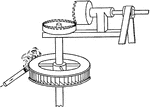
Branca's Impulse Steam Turbine
"In 1629, Branca, an Italian, invented a turbine much like a miniature water wheel, which was driven…

Westinghouse Parsons Turbine Viewed Cross Sectionally
A cross sectional view of Westinghouse Parsons turbine. Steam enters at V and exits at E, turning the…

Early Parsons Steam Turbine
"In 1885, Parsons took out his first turbine patent on a motor along the lines previously suggested…

Hartman's Compound Impulse Turbine
"In 1858, Hartman Bros. patented a turbine consisting of two revolving disks c and c' fixed to a shaft…
